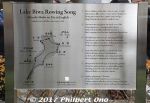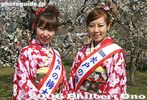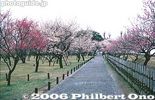 Image search results - "ume" Image search results - "ume" |

Hanegi Park is near Odakyu Umegaoka Station ("Umegaoka" means plum hill). 小田急梅ヶ丘駅
|
|

Welcome to IbarakiTrain platform of Kairakuen Station.
|
|

Yoshino Baigo was a valley and hillside covered with ume plum trees. It boasted a wide variety of different plum blossoms. During full bloom as you can see here, the scenery was spectacular. One of the largest plum groves in Japan.Platform of Hinata-Wada Station with welcome banner 日向和田駅. Banner says, "Yokoso, Ume no Sato Yoshino Baigo." Yokoso means "welcome," and Ume no Sato means "plum town."
To get to Hinata-Wada, you have to change trains at Ome Station on the JR Chuo Line.
|
|

Entrance to Hanegi Park's plum grove
|
|

Train platform of Kairakuen Station
|
|

Closest train station is Hinata-Wada Station. To get to Hinata-Wada, you have to change trains at Ome Station on the JR Chuo Line. 日向和田駅Sadly, spring 2014 was the last time we could see these trees. The plum trees were infected by the plum pox virus and the city cut down all the trees in 2014 to wipe it out. These photos were taken in 2006 when the plums were still fully glorious. Good news is that they have been replanting since 2016.
|
|

The plum trees are on a small hill.
|
|

Train platform of Kairakuen Station
|
|

Although still small, the replanted plum trees have been flowering. and the groves have reopened to the public. Yoshino Baigo poster. Yoshino Baigo is a small town in Ome city near Hinata-Wada Station.
|
|

Hanegi Park has plum blossoms in mid-Feb. to early Mar. It has about 700 plum trees and also sports facilities and public library.
|
|

Plum Blossom Queen at Kairakuen StationShe was passing out maps of the garden. It was a nice touch to see two of these kimono beauties greeting us.
|
|

Road to Yoshino Baigo. Almost the entire town is lined with plum trees.
|
|

To mark the song's 100th anniversary, a new song monument was unveiled at Kyoto University (Yoshida-South Campus) on Nov. 25, 2017.
|
|
|

Plum Blossom Queen
|
|

Tamagawa River as seen from the bridge.
|
|

Front side of the monument has the Japanese lyrics and explanation of the song. Monument is made of stainless steel with a brushed-metal finish.
|
|
|

Entrance to garden via Tokiwa Shrine. One of Japan's three most famous gardens, Kairakuen is especially noted for thousands of plum blossom trees which bloom in Feb. and March.One of Japan's three most famous gardens, Kairakuen is especially noted for thousands of plum blossom trees which bloom in Feb. and March.
|
|

Plum trees line the streets
|
|
|
|
|

Tokiwa Shrine, MitoDedicated to Lord Mitsukuni Tokugawa, the second lord of Mito, and Nariaki Tokugawa, the ninth lord of Mito and the one who built Kairakuen Garden.
|
|

Yoshino Baigo's main attraction is the Ume no Koen plum park. This is an entrance leading to the park.
|
|

Monument's English side has a bilingual Lake Biwa map and Lake Biwa Rowing Song English lyrics.Directions: From JR Kyoto Station's Karasuma side (north side with Kyoto Tower), go to bus stop D2 and catch the No. 206 bus bound for "Gion Via Kiyomizu-dera Temple/Kitaoji Station" (三十三間堂・清水寺・祇園・百万遍). The bus leaves every 15 min. or so (bus schedule here), but it can be very crowded. The ride takes abut 30 min. Get off at "Kyodai Seimon-mae" (京大正門前). Cross the big road (Higashi-Oji-dori) and walk along Higashi-Ichijo street. The main Yoshida Campus will be on the left while the Yoshida-Minami Campus will be on the right. Enter the Yoshida-Minami Campus and walk to the central courtyard area.
(From Kyoto Station, there is also an express bus (京大快速) to Kyoto University Hospital from bus stop D3, but it runs only at certain times on weekdays, mainly in the morning and mid-afternoon (bus schedule here).
|
|
|

Bonsai plum treesI bought one of these once and the flowers smelled good before they withred away. The tree also died soon afterward.
|
|

Ume no Koen park straight ahead, you can see the hill covered with white.
|
|
|
|

Crowd at Higashi-mon East GateThis was the defacto main gate and most crowded since it is closest to the train station.
|
|

Entrance to a temple with a view
|
|

Verse 1 Song Monument, Otsu (Mihogasaki). In 1973, this was the first monument built for the song. The song's first and most famous line, "Ware wa Umi no Ko" is written. 一番の歌碑。大津市三保ケ崎。This monument is near the boat house in Mihogasaki, a stone's throw from Hama-Otsu.
われは湖の子 さすらいの
旅にしあれば しみじみと
のぼる狭霧や さざなみの
志賀の都よ いざさらば
Ware wa Umi no Ko, sasurai no
tabi ni shiareba, shimijimi to
Noboru sagiri ya, sazanami no
Shiga no Miyako yo, iza saraba
|
|

Picnic area
|
|

Map of Kairakuen, a garden built in 1841 by Tokugawa Nariaki (1800-1860), the ninth Lord of Mito. It is one of Japan's three most famous gardens.
|
|

Great view from temple (no admission charge). Sadly, this is no more...
|
|

Stone monument for "Haru no Tsuki" haiku poem by Nakamura Teijo. 「春の月」中村汀女
|
|

Pinickers
|
|

View from temple. The plum pox virus was discovered in 2009. Since then, they have cut down the infected and surrounding trees.
|
|

Stone monument for "Haru no Tsuki" haiku poem by Nakamura Teijo. 「春の月」中村汀女
|
|

Plum blossom-viewing picnickers
|
|
|
|
|

Red and white plum blossoms
|
|

About 120 varieties of plum blossoms are planted, attracting 60,000 to 100,000 visitors during the flowering season.
|
|

Back of Verse 1 Song Monument, Otsu (Mihogasaki)Directions: From JR Otsu Station, take a bus to Mihogasaki. It's about 10 min. Or you can easily walk it from Hama-Otsu Station. Just walk on the main road toward the race boat arena. There will be a small marina on the right. Right after passing the marina, turn right into the small road. There will be a small park on the right. The monument is there. There are two stone monuments. It might be roped off and you're not supposed to enter the park. While you're there, walk around the marina and see the boathouse with the cherry blossom logo with three stripes. That's the logo of the school and the place where the boys left for the rowing trip in 1917. Otsu Station also has a tourist information office where you can obtain directions and a map.
|
|
|
|

Near the entrance to Ume no Koen plum blossom park that opened in March 1972.
|
|

Weeping plum blossoms
|
|

White plum blossoms, the most common variety, and with the sweetest aroma.
|
|

Ume no Koen (Plum Park) is a public park open from 9 am to 5 pm.
|
|

Near the Verse 1 Song Monument is another stone monument engraved with the words of the entire song.
|
|
|
|
|

200 yen admission charged during March only. But I went on April 1 so it was free (and full bloom).
|
|
|

Osaka-zuki red plum blossoms 大盃Osaka-zuki
大盃
|
|

White weeping plum blossoms
|
|

Small park where the Verse 1 monument is located.This monument is near the boat house in Mihogasaki, a stone's throw from Hama-Otsu. It was built in 1973 as the first monument for the song.
This little park is actually off-limits and you're not supposed to enter it, for some reason. On the left side of the picture is another stone monument hidden by brush. It is engraved with the entire song. In the background, you can see the roof of the boathouse.
|
|
|

Plum tree grove, about a week too early.
|
|

Red weeping plum blossoms at park entrance
|
|

Flower pair
|
|

Fantastically-shaped plum tree
|
|

Red weeping plum blossoms
|
|

Higashikurume Station on the Seibu Ikebukuro Line. On the far left is the Fujimi Terrace lookout deck. 東久留米駅
|
|

Entrance to the bamboo grove at Takebayashi Park. 竹林公園
|
|

Near park entrance
|
|

Konan Shomu plum blossom 江南所無Prunus mume Kounanshomu
|
|

Red weeping plum blossoms
|
|

On the west side, Higashikurume Station has a lookout deck called Fujimi Terrace to view Mt. Fuji on clear days. 富士見テラス
|
|

Higashikurume's farming homes used to each have a bamboo grove.
|
|

Plum Blossom Queens in Kairakuen, Mito
|
|

Pink and white weeping plum blossoms
|
|

View of Fujimi-dori road from Fujimi Terrace. Unfortunately, too hazy to see Mt. Fuji. 「まろにえ富士見通り」
|
|

However, due to urban development, the bamboo groves were fast disappearing. So from 1974, the city decided to preserve this one bamboo grove.
|
|

Plum Blossom Queens in Kairakuen, Mito
|
|

White weeping plum blossoms
|
|

A nice short trail goes through the bamboo forest.
|
|

Higashikurume Station
|
|
|
|

Pink weeping plum blossoms
|
|
|

Plum trees and Lake Senba
|
|

With about 1,300 plum trees, this park is probably Tokyo's largest plum tree grove.
|
|

Bamboo forest, Higashikurume, Tokyo
|
|

Plum trees and Lake Senba
|
|

Work of art by nature
|
|
|
|

Plum trees and Lake Senba
|
|

Path in plum park
|
|
|
|
|
|
|

Torano-o plum blossom (Tiger's Tail) 虎の尾
|
|

Path on hillside of plum trees
|
|

Shinsengumi monument 新選組両雄の碑
|
|

In the bamboo forest is one of Tokyo's 57 Famous Natural Springs.
|
|

Pine trees and plum trees
|
|

Hillside plum trees
|
|

Verse 2 Song Monument, Omi-Maiko (Omatsu). On the lake shore in Omi-Maiko (Omatsu) behind Hotel Biwa Lake Otsuka. Built in March 1989. 二番の歌碑。近江舞子(ホテル琵琶レイクオーツカの前)Pine trees are very green, on sands very white.
Omatsugasato is, a young maiden's home.
Bush of red camellia, hides her teary face.
She's weeping o'er a lost love, much too short to last.
Matsu wa midori ni, suna shiroki
Omatsugasato no, otomego wa
Akai tsubaki no, morikage ni
Hakanai koi ni, naku toka ya
松は緑に 砂白き
雄松が里の 乙女子は
赤い椿の 森蔭に
|
|

One of Tokyo's 57 Famous Natural Springs 竹林公園・東京の名湧水57選
|
|

Old photo of Verse 2 Song Monument in Omi-Maiko. The tree was cut down and lyrics later painted white.
|
|

Plum tree grove
|
|

White plum blossoms
|
|

Clear water, but I could not find any spot where the water was gushing out.
|
|

Plum tree and train
|
|

The park has about 120 varieties of plum blossoms. You can see how different they look.
|
|

Verse 2 monument is on the lake shore, in front of Hotel Biwa Lake Otsuka, near what appears to be a boat pier. Short walk from Omi-Maiko Station.Directions: Near Omi-Maiko Station on the JR Kosei Line. After exiting the station, walk left toward Kitahama. Then get to the lake shore and walk along the lakeshore road until you see the monument under a large tree right on the shore. It is in front of Hotel Biwa Lake Otsuka.
|
|

Map to the natural springs.
|
|

Monument proclaiming Kairakuen as one of Ibaraki's 100 Best Sights
|
|

The fragrance is also different. I smelled most of them, and well on my way to becoming a connoisseur of plum blossom fragrances.
|
|

On the way to Takebayashi Park, you can see Ochiai River.
|
|

Poem monument
|
|

Perhaps the most common species of plum blossom.
|
|

Across the road from the Verse 2 song monument is this small music box. Press the button and you can hear the song play (sung by Kato Tokiko).
|
|
|
|
|

Ochiair River with nanohana rape blossoms.
|
|

Closeup of white plum blossom
|
|

Photogenic pink plum tree
|
|
|

Closeup of red plum blossom
|
|

Photogenic pink plum tree
|
|

Ochiair River with rape blossoms.
|
|
|

Rare plum tree with both pink and white blossoms. It has one branch with pink flowers. Never saw that before.
|
|
|
|
|

Plum grove
|
|

Nice riverside path, walk further and you can see another natural spring.
|
|
|
|

Path to natural spring
|
|

These red ones also smell very nice. Different from the white ones.
|
|

Ducks
|
|

Natural spring (cold water)
|
|
|
|

Ikoi no Mizube Park いこいの水辺
|
|

Bamboo grovePine trees, bamboo, and plum blossoms are called Shochikubai in Japanese. This trio of trees is most famous.
|
|
|

Omote-mon GateThis supposed to be the front gate.
|
|
|

White plum blossoms
|
|

Kobuntei Villa has exquisite Japanese-style paintings on paper sliding doors. Kobuntei was damaged by the March 2011 Tohoku earthquake and was closed until early 2012 for repairs.
|
|

View from one observation rest house
|
|

Kobuntei Villa was originally built in 1842 by Tokugawa Nariaki (1800-1860), the ninth Lord of Mito. It was his summer villa.
|
|
|

Kobuntei Villa, fusuma sliding door with painting of plum trees
|
|
|
|

Kobuntei Villa, fusuma sliding door with painting of azalea
|
|
|

Kobuntei Villa, fusuma sliding door with painting of fall leaves
|
|
|
|

In the rear of Ooagata Jinja Shrine, a Plum Garden on a slope.
|
|

Maids to greet you
|
|

Maids, the costume rage in Japan for several years already.
|
|

Welcome!
|
|
|

Tokyo Anime Center
|
|

Many life-size costumed characters on display.
|
|
|
|

Tokyo Anime Center, Akihabara
|
|

Big expressive eyes.
|
|

Straight black hair is pretty too.
|
|

Blue ponytails
|
|

Goldilocks?
|
|

Space teen?
|
|
|

School uniform
|
|
|

Redhead in school uniform
|
|
|
|
|

Kobuntei Villa
|
|

Path going further up the hill
|
|

Ooagata Jinja Shrine Plum Garden 梅園
|
|

Anybody who knows the names of these characters are welcome to enlighten me...
|
|

Sakura
|
|

Merry Christmas
|
|
|
|
|
|
|

Pikachu, Astro Boy, Doraemon
|
|

Cherry blossoms and Ochiai River
|
|

Kobuntei Villa
|
|
|

Weeping white plum blossoms on a slope. 梅まつり
|
|

Verse 3 Song Monument, Imazu. A lantern, at the end of the pier at Imazu Port. 三番の歌碑。今津港の桟橋。夜に赤く点灯。This is at the end of Imazu Pier. At night, this lamp lights up in red. You can see Chikubushima island and Mt. Ibuki in the background.
|
|

Cherry blossoms and Ochiai River
|
|

Kobuntei Villa
|
|

Needless to say, the entire place was filled with sweet fragrance.
|
|
|
|

Verse 3 Song Monument
|
|

Koi in Ochiai River
|
|

Kobuntei Villa, fusuma sliding door with painting of maple leaves
|
|
|
|

Weeping white plum blossoms
|
|

Ochiai River
|
|

Kobuntei Villa
|
|

Spectacular view
|
|

Weeping white plum blossoms 白梅
|
|

Higashikurume manhole
|
|

Kobuntei Villa
|
|
|
|
|

Kobuntei Villa
|
|
|
|
|

Verse 3 Song Monument is written with Verse 3.We drift from wave to wave, straying aimlessly.
On shore we see red fire, brings back memories.
With our sights set nowhere, rolling with the waves.
Today is Imazu or, Nagahama huh.
Nami no mani mani, tadayoeba
Akai tomaribi, natsukashimi
Yukue sadamenu, nami makura
Kyo wa Imazu ka, Nagahama ka
浪のまにまに 漂えば
赤い泊火 懐かしみ
行方定めぬ 浪枕
今日は今津か 長浜か
|
|

Kobuntei Villa
|
|

Path going further up the hill
|
|

Beautiful weeping pink plum blossoms
|
|

Imazu Port. Verse 3 Song Monument is at the end of the dock. The same dock used by boats going to Chikubushima. The dock is usually closed.Chikubushima island and Mt. Ibuki can be seen.
|
|

Kobuntei Villa
|
|

Rest house at top of the hill
|
|

Weeping pink plum blossoms
|
|

Kobuntei Villa, fusuma sliding door with painting of cherry blossoms
|
|

View from top
|
|
|

Kobuntei Villa
|
|

Weeping plum blossoms at the top of the plum tree "waterfall."
|
|
|

Cherry Blossom Room, Kobuntei Villa
|
|

A "waterfall" of weeping plum blossoms しだれ梅の滝
|
|

View of shrine from plum garden
|
|

Kobuntei Villa
|
|

Weeping plum trees part of the "waterfall"
|
|
|
|

Kobuntei Villa
|
|

A "waterfall" of weeping plum blossoms (Shidare ume no taki) しだれ梅の滝
|
|
|

Kobuntei Villa
|
|

Yoshino Baigo plum trees
|
|

Plum blossoms bloom in mid-March
|
|

Kobuntei suffered quite a bit of damage during the big earthquake on March 11, 2011. Repairs have started in Sept. 2011, and they hope to reopen the Kobuntei by Feb. 2012.
|
|

Spectacular viewpoint
|
|
|
|
|
|
|
|
|
|
|
|

Wish the sweet fragrance could come through your computer screen...
|
|
|
|
| 2028 files on 9 page(s) |
1 |
 |
 |
 |
 |
|